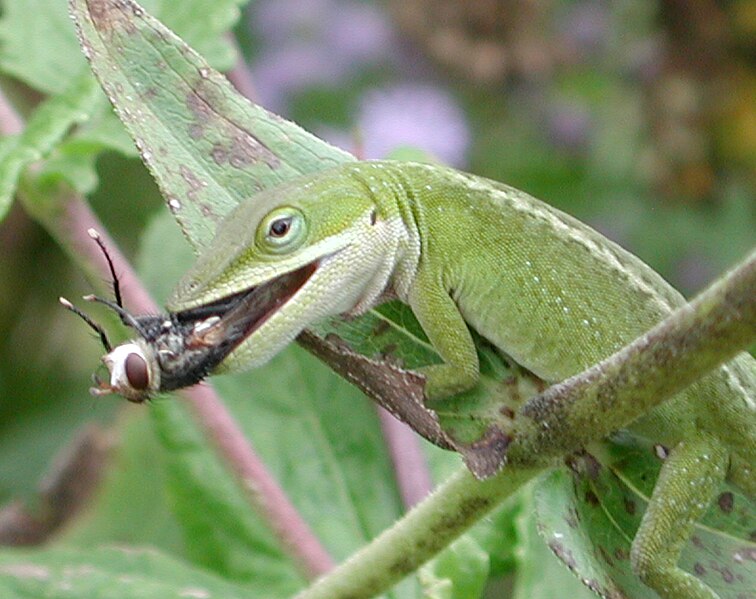I have to start with the lizards. In case you don't know this, little lizards run around everywhere in Florida. They sit on rocks, on window screens. They cling and hang upside down on signposts or tree trunks. They'll dart out of the way as you walk past. Sometimes, if you approach them slowly, they'll do this neck-flare thing. They have a secret flap of skin under their chins and they'll inflate this thing. It doesn't blow up like a bubble but it unfolds more like a wing or a sail of a ship. On some lizards, this flap is red in the center, and on others, it's orange or a yellow-orange.
So I want to know, what is the name of these lizards, what do they eat, what's that flap thing called and what's it for, and what do they do when we're not looking?

This lizard is hanging onto the tree, hoping we don't see him, hoping we'll go away
(Photo from Todd Campbell's page)
- These types of lizards are called Anoles (pronounced uh-no-lees). The most common are the Brown Anoles. Green anoles live higher up in the trees and have become less common.
- Anoles can change their color, but unlike chameleons, they don't change color based on what they're standing on. Their color varies depending on the temperature or their mood, and it takes a bit longer for their color to change.

A green anole, showing its magic flap
(Photo from Cerci's Journal)
- Anoles are usually about 5 to 8 inches long. They have long, thin tails that they can abandon pretty easily, and the tails will continue to wriggle on the ground to confuse or entertain would-be predators while the anoles escape.
- They have little toe-pads at the end of their long, slender toes, which help them to climb and cling to surfaces that appear to be quite smooth.
- Anoles eat little bugs. Sometimes they eat wood roaches or other bugs that can be almost as large as they are. They are sometimes recruited into a yard to help gardeners get rid of pesky insects, though they probably don't consume enough mosquitoes or roaches for people to notice a real difference.

Green anole eating a dronefly
(Photo from Wikimedia)
- Males tend to hang out in visible places, like on the sides of tree trunks or the sides of rocks. Females tend to stay hidden under vegetation or near large rocks.
- Males can afford to be more visible because they have bigger dewlaps. That's right, I said dewlaps. That's what the neck flap thing is called (it's also sometimes called a throat fan). There's a flexible rod of cartilage in the outer ridge of it, and when the anole flexes the cartilage, the dewlap swings into view.

Brown anole with dewlap displayed
(Photo from a blog called Resurgemus)
- The anole will often bob or bounce its head a few times and maybe throw in a couple push-ups just prior to swinging out its dew lap.
- Males display the dewlap to defend their territory, trying to scare off other creatures by flashing the warning red color. They also display the dewlap during courtship.
- The color of the dewlap can change, depending on temperature, time of day, or if the anole is feeling especially ticked off or amorous.
- Anoles came from Cuba and other parts of the Caribbean and were introduced in Florida in the late 1800's. They have since spread from Florida into Georgia and are working their way into other neighboring states. They have been seen hitching rides on the undercarriages of cars, on boats, and even on windshield wipers.
- Their prevalence notwithstanding, they do have many predators, especially cats, snakes, birds, and small children who try to catch them. I guess it doesn't have to be children who try to catch them, because I tried a couple times (and failed; they were too quick for me).
- If an anole gets in your house, the safest way to catch it is to corner and trap it in your hands as gently as possible. The anole will try to look fierce to scare you away, but it's only 5 inches long, is not venomous, and has only little bitty things for teeth. Just drop it back outside and it'll scurry off, glad to get away from you.
- It's best not to keep anoles as pets. They're wild animals and are happier trapping bugs out in the yard where they can find them on their own.

Brown anole, relaxing in grassy comfort
(Photo from Answers.com)
Sources
Florida Gardener, Florida Garden Critters, Green Anole and Cuban Brown Anole
Institute for Biological Invasions, The Brown Anole, by Todd Campbell
Howard Youth, "Florida's Creeping Crawlers," Zoogoer, Smithsonian National Zoological Park, May-June 2005
Welcome home, Apple Lady!
ReplyDeleteWow, thanks, friendly reader!
ReplyDelete